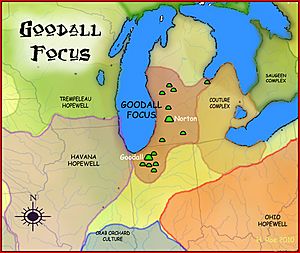Goodall focus facts for kids

The Goodall focus and some of its major sites
|
|
| Geographical range | Great Lakes: Ontario, Michigan, Ohio, and Indiana |
|---|---|
| Period | Paleo-Indians |
| Dates | 200 BCE to 500 CE |
| Type site | Ridgeway Site in Hardin County, Ohio. |
| Major sites | Zimmerman Site, |
| Preceded by | Paleo-Indians |
| Followed by | Point Peninsula complex, Saugeen complex, Goodall focus, and Norton Mound group |
| Defined by | Burials in glacial Kames |
The Goodall focus was a group of people who lived in parts of North America a long time ago. They were part of the larger Hopewell culture. These people lived in western Michigan and northern Indiana. They were around from about 200 BCE to 500 CE.
During this time, people traded a lot with each other. The Goodall focus people were part of these big trade networks. Their territory stretched from the bottom of Lake Michigan across northern Indiana. It went all the way to the Ohio border. Then it went north into central Michigan, almost reaching Saginaw Bay and Grand Traverse Bay. This culture is named after the Goodall site in northwest Indiana.
Contents
What Makes Goodall Focus Special?
The Goodall focus people are known for how they buried their dead. They often used natural hills made of sand and gravel. These hills are called "kames" and were formed by glaciers. Not all burials in a kame are from the same time. But those with similar methods and items are connected to the Goodall focus.
Burial Practices
Goodall focus cemeteries usually had a few to several dozen burials. People were often buried alone, but sometimes in pairs. Their bodies were placed in a tightly bent position. The pits dug for burials were just big enough for the body. If there was hard dirt on top, they made only a very narrow hole through it. Both men and women, of all ages, were buried in these cemeteries.
Special Artifacts Found
Many interesting items have been found with Goodall focus burials:
- Powdered ocher: This is a colorful powder. It contains iron and can be bright yellow to rich orange-red.
- Gorgets: These are flat, decorative pieces. They were shaped like sandal soles or circles. They were cut from large seashells found in the ocean.
- Birdstones: A very unique artifact is the "birdstone." It was usually carved from slate. It looks like the head, body, and tail of a simple bird.
- Spear-thrower weights: These might have been used as weights for spear-throwers. This idea is not fully proven yet.
- Other items: People also found beads made of copper and shell. Some shell beads came from the center part of ocean shells. Long bone pins and bone awls (sharp tools) were also common.
Goodall Focus Pottery
Scientists have found pieces of pottery from the Goodall focus. These pieces usually come from "middens", which are ancient trash piles. The pottery often has marks from expanding and contracting stemmed projectile points. Small pieces of obsidian (a type of volcanic glass) have also been found.
Research on Goodall focus sites has been happening since the 1990s. Sites in northwest Indiana, the Galien River Basin, the Kalamazoo River Basin, and the Grand River basin have been studied.

